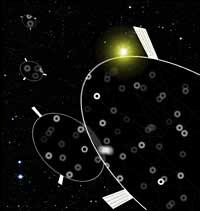Who is more absurd?
2006/11/08 Carton Virto, Eider - Elhuyar Zientzia

He has made the proposal very seriously. According to him, it is possible that between the Sun and the Earth small discs are placed, as light as the feathers. The disc consists of transparent materials that will refract sunlight and will be able to divert 2% of the radiation emitted by the Sun to Earth. According to Angel's calculations, this would compensate for the warming caused by the doubling of the CO 2 level in the atmosphere. Absurd?
Most of us would answer yes. Angel, however, has calculated everything quite accurately. How many discs are needed, how, how they will be projected and placed in place, what technology will be used, how long and how much money will be needed to do so. The idea was presented last April at the U.S. Academy of Sciences and in July won a money bag from NASA's Institute of Advanced Concepts to advance research. He has now published the details of the project.
It is not the first intention to place a barrier between the Sun and the Earth. In 1989 a shield of 2,000 kilometers of diameter was proposed. To do this, the first thing we had to do was to colonize the Moon, since there it had to be built and thrown out of hiding.
Another ancient idea is to enrich the atmosphere with sulfur to imitate the phenomenon observed with volcanic eruptions. In fact, the sulfur of the stratosphere reflects the rays of the sun, thereby cooling the Earth. The idea is old and has never been taken seriously, but last summer it was recovered by Paul Crutz's Nobel Prize. The Nobel Prize in Chemistry at Crucis has been received for his research on ozone and, according to him, has taken up this idea for the lack of international initiatives to reduce greenhouse gases.
But despite receiving the support of a rewarded Nobel, these geoengineering projects have little follower and credibility today. From World War II to the 1970s, the U.S. and the Soviet Union invested a lot of money in climate control and manipulation projects (they saw it as a weapon of war), but since then they are totally disoriented. Moreover, whether possible or not, geoengineering projects are not politically correct; the hope of sophisticated technological solutions can cause society to calm down, but especially those who are skeptical of climate change often use them.
Precisely with this reflection begins the article on the subject written by NASA researcher Gavin Schmidt on the blog RealClimate, which has long become a reference space on climate change. He sees no future for Crutzen's proposal, and uses an analogy that I will maliciously develop a little more to explain the causes.

Schmidt compares the climate with a offshore boat. The comparison indicates that the risk of overturning the vessel is finite under normal conditions, but increases if one of the passengers stands and the boat starts to move sharply. In this situation, another passenger of the boat proposes a solution to the risk: neutralize by a system based on chaotic dynamics the movement of the passenger standing and the one produced by the waves. But for this you need a lot of sensors and a huge computing capacity, and also you can not ensure the total stability of the container, and even, having never tested the system, it is possible that the situation worsens. Schmidt concludes the article with a question: will we continue this strategy to fight climate change? Or are we going to sit the passenger standing?
Let him feel, of course. No doubt. Angel and Crutzen have also said the same thing. And I too. And almost all. The truth is that all who are standing in the climate ship are involved in Nairobi, and speak for the umpteenth time of sitting, and some do not admit to standing.
Published in the newspaper Berria.




